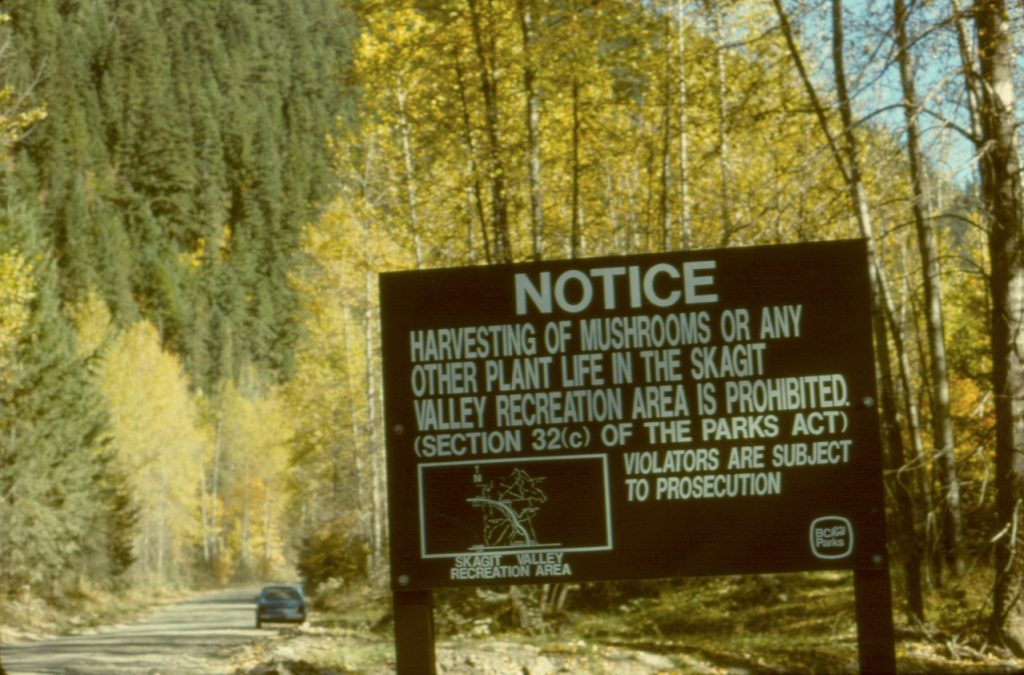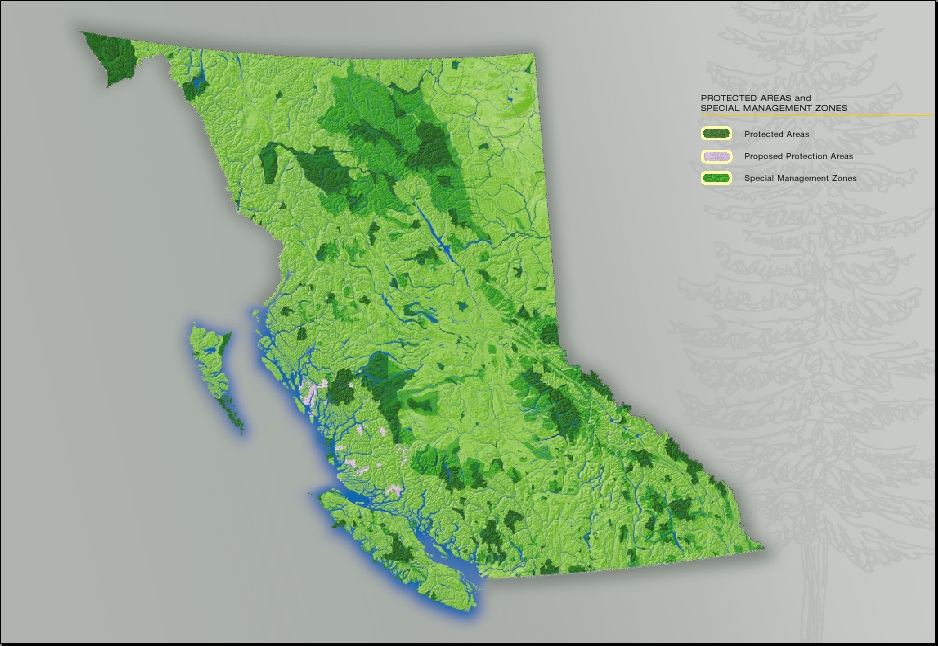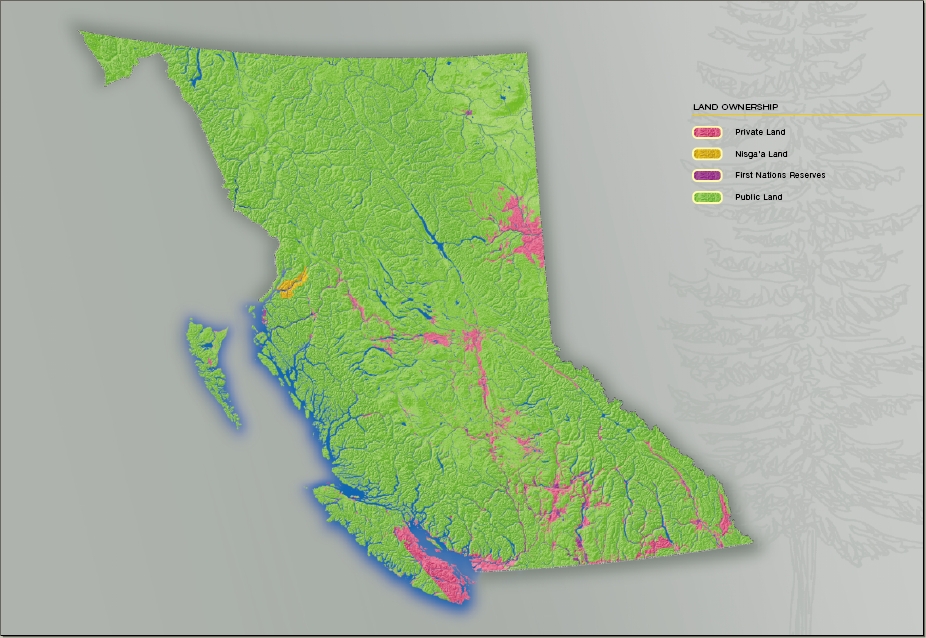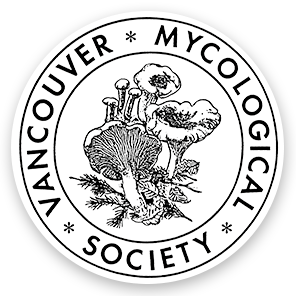
Where You Cannot Pick Mushrooms
Mushrooms picking is prohibited in all National Parks, in all Provincial Parks, in all Ecological Reserves and in Regional Parks in British Columbia.
Mushroom picking is also prohibited in all Provincial Conservancies and Recreation Areas and Trails. British Columbia Parks administers these lands under the British Columbia Park Act: Park, Conservancy and Recreation Area Regulations.
Mushroom picking is also prohibited on all Department of National Defense (DND) lands.
Designation of lands under special management such as First Nations management areas, Heritage Sites or Conservancies, may prohibit removing of mushrooms and other non-timber forest products (NTFPs). Community Forests may require permits for removing of mushrooms and other NTFPs. BC Parks can provide information on where mushroom picking is a prohibited activity in British Columbia.
See the Map of British Columbia showing parks and other protected areas below

Protected areas & special management zones in BC
Where You Can Pick Mushrooms
Permission must be obtained to gather mushrooms on all privately owned land, leased Crown Lands and on Indian Reserves.
Mushroom harvesting is allowed on all Provincial Forest Crown Lands in British Columbia. This includes Crown Lands within Tree Farm Licenses (TFLs) and Timber Supply Areas (TSAs).
Various regulations and laws govern access to and use of crown lands and access roads. It is the responsibility of people wanting to gain access to check for road closures or limited hours of public access to active logging roads, and any other special regulations that may apply. Mushroom picking is allowed in most Ministry of Forest Recreation Sites and Trails.
Most commercial mushroom harvesting takes place on forest lands in Tree Farm Licenses or TFLs, which cover much of the province’s forest land base.
See the Map of British Columbia showing crown lands in green below

Public (Crown), private, Nisga’a, and First Nation reserve land in BC – Click here for an interactive map
When to Pick Mushrooms
The growth of mushrooms is limited by availability of water and by temperature. Temperature controls water availability for fungi; high temperatures speed evaporation drying things out while very cold temperatures freeze water making it inaccessible.
Near sea level in our mild and moist climate there may be mushrooms almost any time of year, when there is adequate moisture and temperatures above freezing.
On the northern Pacific coast our major mushroom season is autumn. The autumn or fall mushroom season usually starts towards the end of August as night temperatures begin to cool creating heavy dews. Some kinds of mushrooms such as Amanita and Russula species are associated with mild late-summer and early autumn temperatures. The first rains following a dry summer may take some time to penetrate and replace soil moisture and to trigger mushroom growth. A week or two may pass before the first mushrooms begin to appear.
With the onset of autumn rains and as days grow shorter and temperatures cooler a succession of species appear. The greatest variety and abundance of mushrooms is usually found in October. An abundance of mycorrhizal mushrooms in autumn may be due to trees transferring sap and sugar reserves into their root systems for storage during winter dormancy.
Some mushrooms such as many Hygrophorus and Tricholoma species are late season mushrooms; only appearing as temperatures drop to near freezing. The Pine Mushroom (Tricholoma magnivelare) crop often peaks following the first light frosts of late fall.
Autumn mushroom season usually ends with severe night frosts freezing the ground or the onset of freezing daytime temperatures and snow. Even after freezing has set in there are some winter-fruiting mushrooms still capable of growing and developing. Mushrooms such as the Winter Oyster Panellus serotinus, Winter Chanterelle Craterellus tubaeformis and Enoki mushroom Flammulina velutipes produce natural anti-freeze substances, and may be found throughout mild winters.
Spring mushroom season is an interesting time. The ground is sodden from winter rains and snowmelt and begins to warm, and certain mushrooms grow that won’t appear at any other time such as the highly sought after edible morels. The spring season is characterized by the diversity of large ascomycetes; such as the morels, early morels, false morels, cup fungi and earth tongues. A variety of jelly fungi and certain gilled mushrooms also appear as uniquely spring-fruiting species.
The initial event in the spring mushroom season is the emergence of “snow bank” mushrooms growing where the forest floor is exposed after melt-off of winter’s accumulated snowpack. During winter debris and forest litter such as tree needles and cone scales and seeds, bits of bark, mosses and lichens dislodged from tree canopies become entrapped within the snowpack. When the snow eventually melts this organic detritus is concentrated and remains as a wet, nutrient-rich layer on the surface of newly exposed ground. A distinctive community of fungal species exploits this seasonal resource.
Most of the mushrooms of the spring season are found as trees and shrubs emerge from their winter dormancy. From the beginning of sap-run through leaf bud-break and the emerging and hardening off of fresh spring foliage there is a succession of seasonal specialists. Organic nutrients in the form of sugars, manufactured by plants and stored in below-ground root systems through winter dormancy, become available again as the sap flows and trees resume active growth.
Many spring mushrooms seem to require particular soil temperatures to initiate fruiting. Slopes warmed by early spring sunshine produce mushrooms earlier than more shaded cooler locations.
Some spring mushrooms have very specific fruiting periods. The early morels, Verpa bohemica and Verpa conica, begin to fruit just after trees’ bud-break; while the true morels develop a few weeks later, after the first flush of leaves have opened and begun to harden. Morels often grow in areas where Calypso orchid flowers are fully open, or where apple or wild crabapple trees are blooming or nettles are 5 ½ inches high. Morel enthusiasts have various “rules” for when to find their quarry.
Large crops of morels are often produced in burned areas the spring after a forest fire. Because of this, morel pickers follow the fires of the previous year to harvest these choice delicacies which are then dried for future use.
Morels are the most popular spring edible mushrooms but there are also spring boletes related to King boletes that are esteemed edibles, and spring oyster mushrooms and edible Agaricus species can be found in spring in BC.
The low season in the mushroom year is often summer when clear sunny weather and high temperatures dry out the ground and forest floor. Even occasional rain showers might not allow growth of many mushrooms, and breezes and wind can soon suck out what little moisture becomes available.
In a wet summer, though, many unusual warmth-loving mushrooms might be found that are rarely seen. Even in dry summers some fungi will continue to grow their fruit bodies. The wood rotting tree fungi, especially those with perennial shelf or hoof shaped “conks”, continue to draw water from the reserves of large sodden logs and stumps. This is when the annually fruiting edible “chicken of the woods” Laetiporus conifericola (on conifer trees) or Laetiporus gilbertsonii (on deciduous trees) is found.
The procession of different mushroom species through seasons of a year can be fascinating to watch. Following mushrooms of an area over several years also reveals great year to year variation in mushroom occurrence. It may take many years, even decades, to begin to see the actual mushroom diversity of an area.
How to Pick Mushrooms
Harvesting mushrooms for food
Pickers gathering edible mushrooms usually use rigid and easy to carry containers such as baskets or plastic buckets or pails with drainage holes in the bottom to avoid accumulation of rain water. Plastic bags are not suitable for collecting quantities of mushrooms because they cling and stick to mushrooms and cause them to be easily broken and sodden with water.
Mushrooms gathered for eating are given a preliminary cleaning or trimming and placed loose in the container. Pickers will usually carry a knife, often with a dull blade, to pry out mushrooms and for trimming them, and brushes or pieces of cloth or foam sponge are useful for cleaning away debris and soil. Only well known familiar edible species should be put together. Any unknown mushrooms gathered for later identification should be kept separate from edibles. This prevents possible contamination of edibles from contact with poisonous species.
When gathering mushrooms, either for personal or commercial purposes, there are some good practices and some bad. Harvest should be conducted to minimize disturbance to the mushroom habitat and leave an area as pristine as possible. Some opposition to recreational and commercial harvesting of mushrooms has resulted from irresponsible activities that result in damage to and degradation of natural areas.
Mushroom picking camps have been associated with unsightly accumulation of trash and garbage, contamination of waters and the ground with human wastes, and damaging and degradation of areas from temporary structures and vehicle access.
Social problems and conflict may arise in communities from a seasonal influx of mushroom harvesters who lack a connection to the land and its people, and who don’t develop a connection, but exploit the resource and move on.
The search for valuable Pine Mushroom buttons has resulted in the raking-back of the forest floor to expose young developing mushrooms hidden below the surface. This practice damages the fine shallow roots of host trees, delicate understory herbaceous plants and moss and lichen layers, and ironically is inefficient proportional to the energy expended, despite the damage caused.
Pine mushrooms are unique among commercially harvested mushrooms because they are only marketable when whole, with the base intact. Most other mushrooms are harvested with the stem base trimmed off. Fortunately, the Pine mushroom is easily harvested with the base intact, and with minimal disturbance to the forest floor, by employing a gentle rocking and twisting motion to ease it out of the ground. Displaced layers of the forest floor should be restored, patted back into place, after removing mushrooms.
Most mushrooms are gathered, transported and stored with the stem bases trimmed off. This is for practical reasons; to avoid introducing soil, debris and forest litter thus ensuring a cleaner product, and to check for insect larva or “worms”, or for other damage and decay.
There has been much debate about whether removing mushrooms with their stem base injures the mushroom mycelium, and whether cutting the stem at ground level is necessary to sustain productivity of a mushroom patch. Some research indicates that plucking the fruit bodies of golden chanterelles with the base intact did not diminish yield over a period of several years. Harvest plots with mushrooms cut at ground level and bases left in place appeared to show a slight decrease in productivity.
Pickers should only take what can be used and leave mushrooms that are under-developed or old and past their prime. It is far better to be selective in the mushroom patch than to gather indiscriminately; and the picker benefits by having less work ahead in sorting and cleaning the day’s harvest.
It’s good practice to leave trimmings and discarded mushrooms, discretely, within the forest habitat. It is not good practice to unduly disturb and destroy random mushrooms and other natural components of the forest floor. It’s discouraging to find a forest floor littered with overturned and broken mushrooms. Mushrooms picked for casual examination should be replaced in their niches to continue releasing spores.
Collecting mushrooms for study or display
Collecting mushroom specimens for identification, research or display purposes is different than gathering well known familiar edibles for consumption. For identification purposes you want to remove the whole mushrooms with the base intact and often with some substrate. Very important features for identification may be lost if the base is missing. An ideal collection of a mushroom species for identification, research or display will include different growth stages and ages. Different developmental stages can yield valuable clues to identity.
For identification or display purposes collections are usually wrapped separately in waxed paper or foil or placed in separate rigid containers. This helps preserve delicate structures that are valuable clues for identification and prevents mixing up of different specimens. Plastic containers with many compartments, like small fishing tackle boxes, are great for small samples. Note should be made of the habitat a collection was growing in and what trees are present. Including a few leaves, bits of moss or tree needles with the sample can help you recall associated trees and plants.
Mushroom specimens for research and study are preserved by being dried and retain intact microscopic structures that are used for technical identification. DNA studies are also conducted using dried voucher specimens. Dried specimens for scientific research are kept in a collection called a Herbarium which is a vital and valuable resource for studying biodiversity.
Herbaria with most of the preserved mushroom collections from British Columbia are UBC in Vancouver, DAVFP at Pacific Forestry Centre in Victoria and DAOM at the Central Experimental Farm in Ottawa.
Amateur mushroom enthusiasts can contribute to scientific knowledge by collecting, photographing and preserving interesting mushroom specimens for experts to study and identify later. Amateur enthusiasts frequently discover new mushrooms previously unknown to science.
By Paul Kroeger. Revised February 25, 2018.
